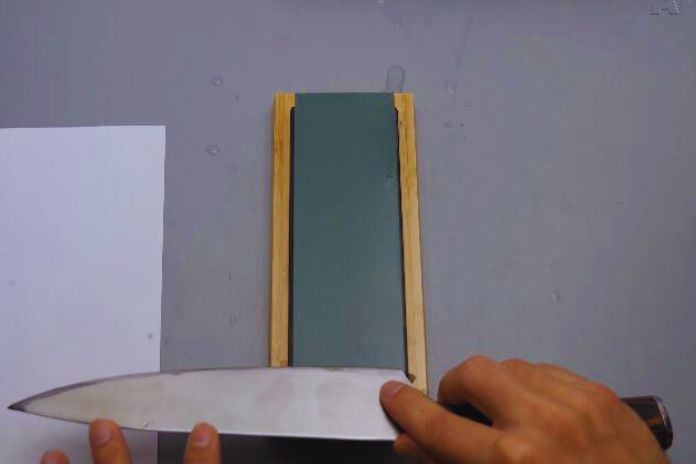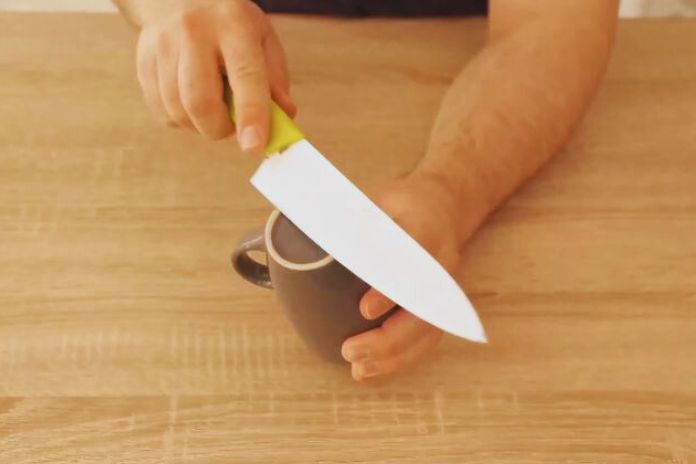A sharp knife is an important tool in the kitchen or out in the wild. A sharp knife gives precise cuts and saves accidental cuts from slipping. If your knife turns dull, then it increases the risks of dangerous slips while using it. But what if you find yourself in a situation where your sharpener is nowhere to be found?
You can also sharpen your knife with some traditional tools and stones anywhere. We have researched and tested many methods to sharpen a knife blade without an expensive sharpener. This knife sharpening guide will cover all possible methods, from household items to natural resources.
Effective ways to sharpen a knife without a sharpener
You can sharpen a dull knife without sharpening tools at home with your household items. These sharpening DIY methods are manual and risky if you don’t read the precautions carefully. It would be best if you took safety measures before trying blade-sharpening hacks.
Top Tools to use:
- Sandpaper
- Honing rod
- Using Whetstones
- Coffee mug
- Leather Belt
- Using a Bottle of Glass
- With Car Window
- Sharpening with Aluminum Foil
Method 1: Sandpaper for Sharpening Knives
Sandpaper is the best alternative to a knife sharpener to sharpen your dull knife blade. You must choose between 1000 and 3000 sandpaper for sharpening knives for better results. Use water or oil to wet the sandpaper to reduce heat buildup. Put your sandpaper on a flat surface and rub your knife across the edges at the best angle. It will remove the dullness of the knife and give a fine finish. If you have low-grit sandpaper, it can remove more material from the blade.
You can also use a nail file in the absence of sandpaper. The best thing about the nail file is that it comes only with survival kits for hunters. You can sharpen the knife by rubbing the blade on the nail file, as on sandpaper.
Different grits for different needs
Different grits are used for different purposes, so choose the best grits for the situations. If you want to recover damaged edges, 1000-1500 grits are the best option. 2000-3000 are ideal for routine maintenance and sharpening. Fine grits 4000-8000 provide a polished, razor-sharp edge.
Method 2: Using an Honing Rod
Honing rods are the 1st choice of senior chefs to maintain their steel knives. This comes with ridged steel to keep the knife blade working. Take a honing rod vertically and fix it on a flat surface. Put your knife on the rod at 20- degrees and swipe it down to fine the damaged edges. Repeat the process on the other side of the blade. It doesn’t remove the material as a sharpener does.
Your knife gets dull without maintenance. You can increase the durability of the knife by honing it after every use in the kitchen. Mostly, knife sets come with a honing steel for regular use. If you don’t have one, you can buy an affordable honing steel on Amazon for 40-100$. Choose the 9-inch honing steel that gives you a professional, smooth feel while honing a blade.
Method 3: Using a Whetstone
Using a whetstone is the most traditional and effective way to sharpen the blade. Use affordable whetstones to sharpen your kitchen knife blade at home. Put your whetstone on the table with the coarse side facing up. Wet the stone with water or oil. Give back-and-forth motion on the stone at a 20-degree angle along the edges. Repeat it on the other side and check the sharpness of tomato or onion.

Method 4: Sharpening a knife with a coffee mug
The ceramic coffee mug is also amazing for sharpening a knife by removing material from the knife. Coffee mugs are available in every kitchen. Take a ceramic coffee mug and find an unglazed bottom part to sharpen a knife. Hold the knife at a 20-degree angle and rub it on the rough surface. It will help you to remove rust particles and sharpen the knife. You can test the sharpness on paper.

Method 5: Sharpening with leather belts
Leather strips are an outdated but effective way of stropping knives by barbers. Attach a leather strip to a solid surface and polish it. Draw the knife across the leather to improve knife sharpening. Rub from the other side to clean the rust off it.
Method 6: Using a broken bottle glass
The glass bottle is also an old method to sharpen the blade. In WWII, soldiers used glass to sharpen the carbon steel blade by rubbing it back and forth. It would help if you wrapped the bottleneck with a cloth for safety. Rub the blade on the rough edges of broken glass to remove rust.
Method 7: Sharpening a knife with a car window
The top edge of a car window is also used to sharpen the knife. Just find the rough edge of the window and swipe the knife back and forth across at 20 degrees.
Method 8: Sharpening a knife with aluminum foil
Another kitchen item is aluminum foil, which can help increase your knife’s performance. Fold a piece of aluminum foil to make it a ball or square. Glide your knife’s edges at 20 20-degree angles to hone the knife. We have not tested this method ourselves, but housewives recommend it.
Mastering the art of sharpening a blade without a sharpener is a ninja skill for chefs and outdoor enthusiasts for knife care. These disposal household items are also helpful in blade care to assist you in kitchen and outdoor activities.
Pro Tips:
- Hold the knife at the best angle while sharpening.
- Use light pressure when sharpening to avoid damaging the blade.
- Test the knife’s sharpness by gently slicing through a piece of paper.
- Regularly clean and dry your knife to prevent corrosion.
FAQs
Can I sharpen a knife with a nail file?
You can sharpen your pocket knife with nail foil by rubbing it on its surface.
Can you sharpen a knife with tin foil?
Tin foil can extend the life of a dull knife but can’t be used to sharpen a knife.
What is the best method for home knife sharpening?
The whetstone is the best method to sharpen a knife at home.
What happens if you don’t sharpen a knife?
You may damage the edges badly by sharpening a knife the first time.